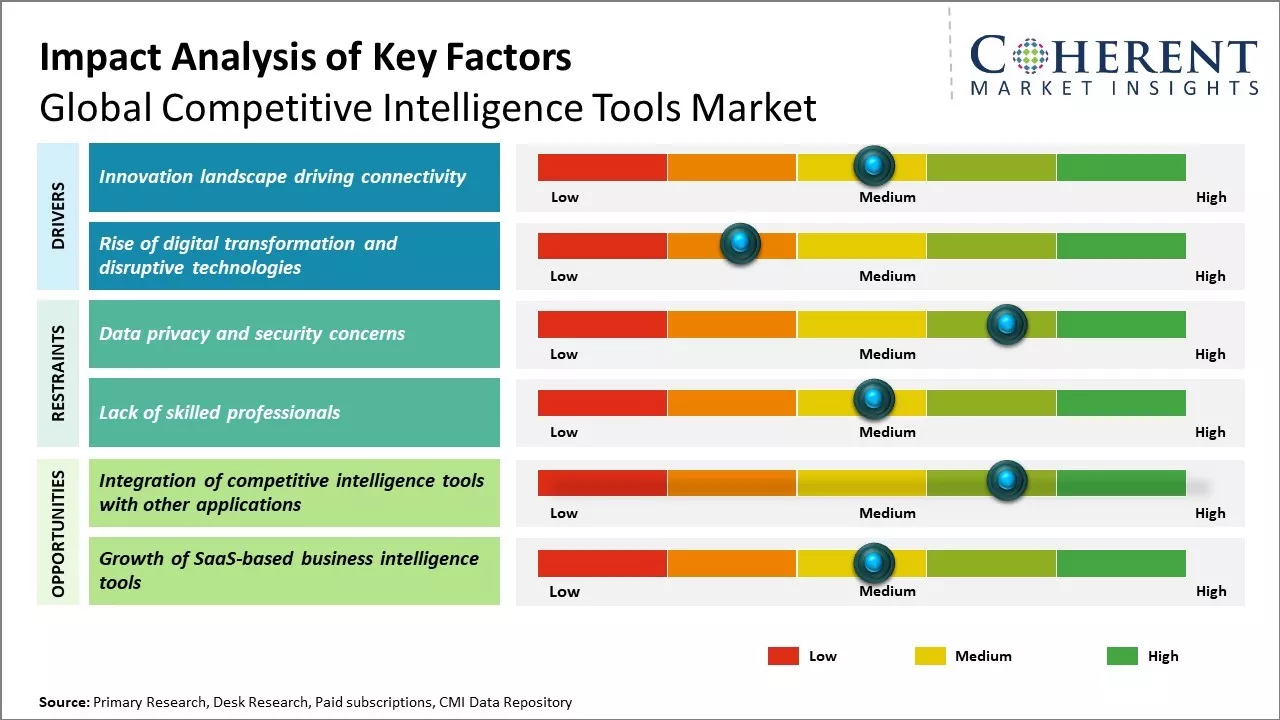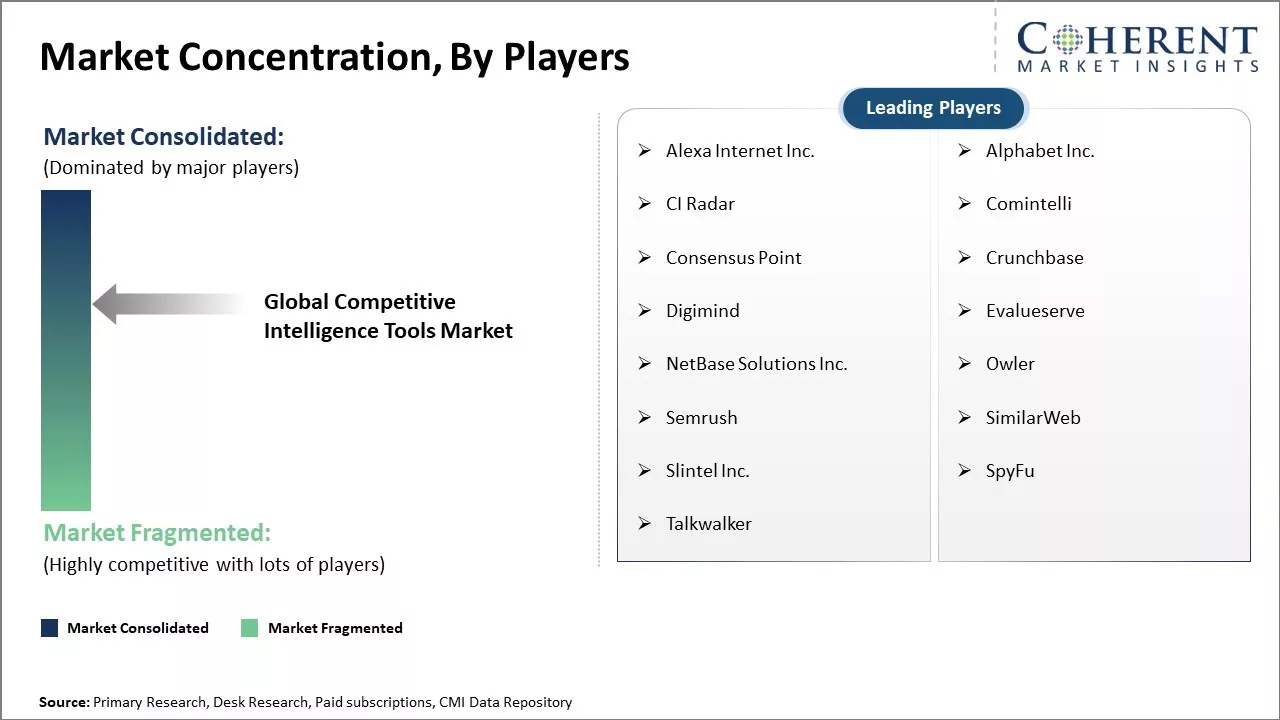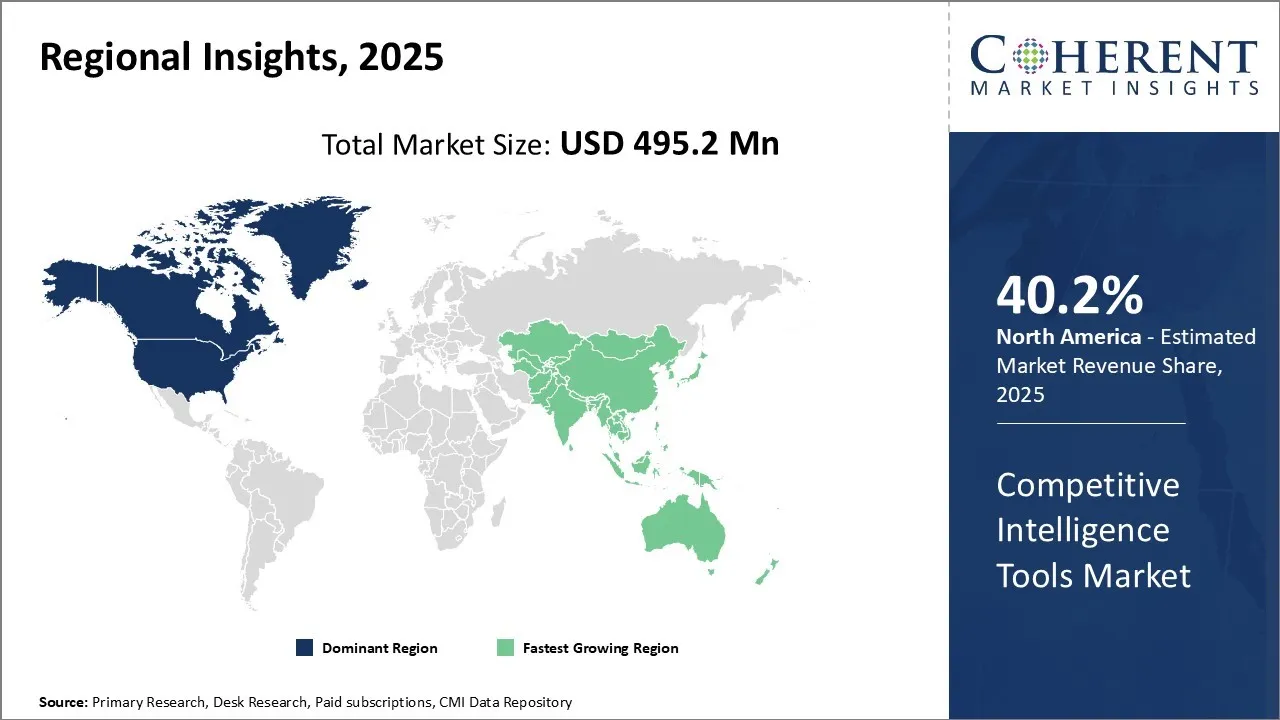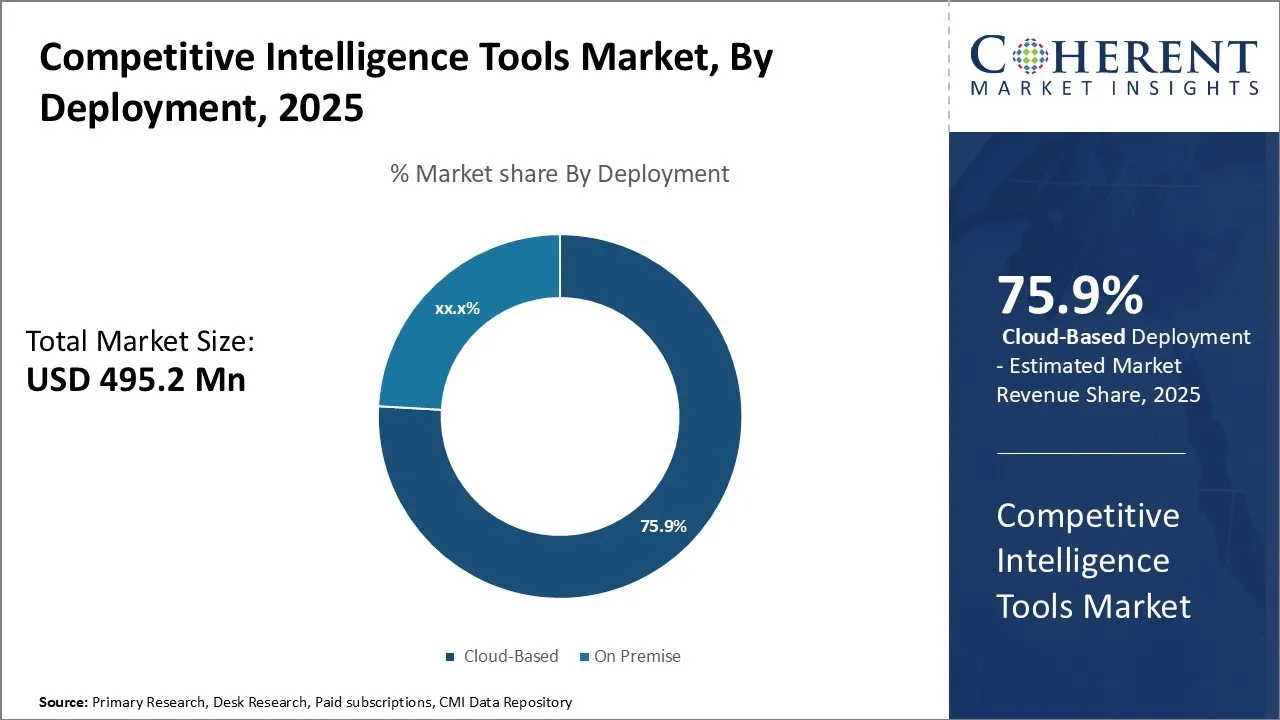Global Competitive Intelligence Tools Market Size and Share Analysis – Growth Trends and Forecasts (2025-2032)
Global Competitive Intelligence Tools market is estimated to be valued at USD 495.2 Mn in 2025 and is expected to reach USD 1,123.0 Mn by 2032, exhibiting a compound annual growth rate (CAGR) of 12.4% from 2025 to 2032.

To learn more about this report, Download Free Sample
Key Takeaways
- On Basis of Deployment, Cloud-Based Segment within the competitive intelligence tools market is estimated to hold the largest share of 75.9% in 2025. This is due to the growing preference among companies for more scalable and flexible deployment options.
- Based on End User, The Industrial Segment is estimated to account for the 42.2% share of the competitive intelligence tools market among different End User categories in 2025. This is because companies operating in the industrial sphere have substantial upstream and downstream market monitoring needs to gain a comprehensive overview of their supply and distribution chains.
- North America continues to dominate the global competitive intelligence tools market with 40.2% market share. This is because the region is home to some of the largest corporations in sectors like technology, healthcare, and manufacturing which are the key adopters of competitive intelligence solutions.
Market Overview
The global competitive intelligence tools market growth can be attributed to the growing adoption of competitive intelligence tools by various organizations to gain valuable insights about their competitors and optimize business strategies. Integration of advanced technologies like artificial intelligence, machine learning, and analytics in competitive intelligence tools is also fueling their adoption. Key players operating in the market are focusing on new product launches and enhancements to consolidate their market position. Adoption of cloud-based deployment models for these tools is gaining traction as they offer benefits like scalability, flexibility, and low costs. Thus, continuously evolving technology along with growing need to gain competitive edge will drive demand for competitive intelligence tools in coming years.
For example, in May 2024, Contify unveiled 'Contify Copilot,' which is an AI-driven conversational interface that provides users with instant and precise responses to their intelligence questions without having to dig through large amounts of information.
Current Events and Its Impact on Competitive Intelligence Tools Market
|
Current Events |
Description and its impact |
|
Adobe Releases "LLM Optimizer" in Experience Cloud |
|
|
One Trust Introduces Copilot for Privacy and Risk Intelligence |
|
Uncover macros and micros vetted on 75+ parameters: Get instant access to report
Pricing Analysis -Competitive Intelligence Tools Market
The Competitive Intelligence (CI) Tools industry has a technology-integration, deployment model, and target customer base-driven dynamic price model. Price is typically between subscription SaaS-based models and enterprise license agreements. The market-leading SaaS models have tiered price models based on user seats, volume of data, and feature accessibility, making such solutions small and medium business as well as large corporation-friendly scalable and flexible.
Basic plans are around $50 to $200 per month per user, offering basic competitive data tracking, reporting, and alerting features. Midrange solutions range from $200 to $1,000 per month and include more in-depth analytics, machine learning-driven insights, and integration with other business intelligence tools. Enterprise premium solutions are over $1,000 per month and are geared towards large businesses with high-end data requirements, advanced machine learning models, and special support.
Cloud deployment is making pricing more economical with reduced IT overhead and easier scalability. Freemium or trial versions for free are being offered by vendors for motivating adoption by small businesses, with upselling for higher-tiered features. Embracing machine learning and AI technologies is also driving the cost upward on the strength of more accuracy and actionable insights.
Geographic variation affects pricing, with Europe and North America typically having prices that are higher as a consequence of higher technology adoption costs and compliance costs. Emerging economies would anticipate more forced pricing in pursuit of penetration.
CI tools market pricing strategy strikes a balance between affordability and richness of features so that companies in industries can reap the benefits of competitive insights without spending too much initial capital, thereby fueling widespread market growth.
Role of Advanced Technologies
Emerging technologies are revolutionizing the Competitive Intelligence (CI) Tools industry by upgrading data gathering, analysis, and actionable insight generation, thus facilitating companies to make smarter strategic decisions.
Artificial Intelligence (AI) and Machine Learning (ML) fuel the revolution, analyzing vast amounts of unstructured and structured data from various sources like social media, news, financial reports, and competitor websites. These technologies allow predictive analytics, trend identification, and anomaly identification, enabling companies to predict competitor actions and market trends with greater certainty.
This facilitates real-time sentiment analysis and monitoring of competitor strategies, giving organizations rich competitive insights. Cloud computing is a choice enabler by providing flexible and elastic deployment models, enabling instant access to data and collaboration by global teams without the need for significant upfront investment in infrastructure. The cloud also enables easy integration with other enterprise applications like Customer Relationship Management (CRM) and Enterprise Resource Planning (ERP) to form an integrated data ecosystem.
Big Data analytics complements the capacity for ingesting and processing large, complicated sets of data in a timely fashion so that CI platforms are able to keep pace with the increasing volume and variety of sources of data. Automated functionalities such as AI-powered chatbots and dashboards offer user-friendly interfaces for non-technical personnel for interacting with competitive intelligence insights in an effective manner.
Generally, the incorporation of new technologies into CI tools is pushing innovation forward faster, enhancing accuracy, saving analysis time, and making competitive insights more democratized—making the tools essential for businesses that seek to hold on to their competitive edge in rapidly changing markets.
Market Concentration and Competitive Landscape

To learn more about this report, Download Free Sample
Market Driver
- Innovation landscape driving connectivity
With more businesses opening up their innovation landscapes and outsourcing research to other entities, there has been a significant rise in cross-company collaboration. This has enabled greater connectivity between organizations and their external partners which is fueling the need for competitive intelligence tools. These tools provide up-to-date access to partners' joint research projects, allow for seamless communication exchange, and facilitate resource and knowledge sharing in real-time.
Having a centralized platform to track external partnerships virtually across borders is helping align innovation strategies. It gives leadership teams a unified view of competitive threats and opportunities emerging from these collaborative networks. The adoption of competitive intelligence solutions has helped break departmental silos and foster collaborative innovation cultures even in largely decentralized structures.
In April 2025, UK-based innovation management platform Wazoku announced a collaboration with China’s National Innovation Center par Excellence (NICE) in the Yangtze River Delta. This partnership brings together multinational corporations, startups, and academic institutions on Wazoku’s cloud-based platform to co-create and manage research projects, challenges, and idea portfolios in real time.
- Rise of digital transformation and disruptive technologies
One of the major shifts witnessed in recent years is the scale and pace at which digital disruption is transforming industries. Emerging technologies around artificial intelligence, machine learning, IoT, blockchain have really accelerated this phenomenon. Every business today has to continuously evolve its business models, product/service offerings, operational processes, and customer engagement strategies to address these paradigm shifts.
Competitive intelligence tools play a vital role in helping organizations understand external technology shifts and benchmark themselves against innovation leaders. These solutions aggregate and analyze troves of both structured and unstructured data to identify technology trends at an early stage. They also provide insights into competitors' tech adoption journeys, investments in breakthrough areas like autonomous systems, augmented reality etc.
Armed with these insights, businesses can proactively reshape their digital transformation roadmaps and carve out new market positionings by developing disruptive solutions ahead of competition.
Market Challenges: Data privacy and security concerns
The increasing data privacy and security concerns among organizations and individuals have become a major hindrance for the growth of the global competitive intelligence tools market. With data privacy regulations getting stricter across regions, organizations are hesitant to widely adopt CI tools that may compromise sensitive consumer and business information.
The introduction of strict data privacy laws like General Data Protection Regulation (GDPR) in European Union and California Consumer Privacy Act (CCPA) in the U.S. has compelled CI tool providers to revamp their products and ensure highest standards of data security. However, overhauling existing tools or building new tools from scratch to meet evolving compliance needs is expensive and time consuming.
Many smaller players in the competitive intelligence market are finding it challenging to invest heavily in data privacy measures. The lengthy product development cycles of competitive intelligence tools and compliance uncertainties end up deterring businesses from subscribing to newer tools.
Market Opportunities: Integration of competitive intelligence tools with other applications
The integration of competitive intelligence tools with other key applications like CRM, business intelligence, and analytics tools provide a huge opportunity for growth in the global competitive intelligence tools market. As business processes become more data-driven and collaborative having access to competitor data and insights within the regular workflow of other business-critical applications removes silos and brings strategic decision making to an operational level.
Competitive Intelligence Tools Market Insights, By Deployment
By Deployment, cloud-based segment within the competitive intelligence tools market is estimated to hold the largest share of 75.9% in 2025, owing to the growing preference among companies for more scalable and flexible deployment options. Cloud-based platforms offer competitive intelligence teams the agility to scale operations up or down depending on shifting needs, without requiring large upfront capital investments in on-premise servers or related IT infrastructure.
This makes cloud services very appealing especially to smaller or mid-sized firms with fluctuating research volumes. The operational expenditures model of the cloud also allows for greater budgetary predictability versus one-time software licenses.
Additionally, cloud solutions provide users with access to their tools and sensitive intelligence databases from any internet-enabled device. This allows research teams to stay connected to their resources while mobile or working remotely. The ability to collaborate seamlessly from different locations in real-time is a key driver behind the popularity of cloud competitive intelligence tools.
Competitive Intelligence Tools Market Insights, By End User
The industrial segment is estimated to account for the 42.2% share of the competitive intelligence tools market among different End User categories in 2025. This is because companies operating in the industrial sphere have substantial upstream and downstream market monitoring needs to gain a comprehensive overview of their supply and distribution chains.
Competitive intelligence solutions provide industrial firms with valuable insights into emerging technologies, product innovations, regulatory changes, competitor strategies and pricing trends within their vast network of customers and suppliers.
Additionally, industrial verticals like manufacturing, chemical processing and construction require a steady flow of timely insights to efficiently manage global sourcing, logistics and capacity planning. The continuous intelligence provided by specialized platforms ensures industrial decision-makers have competitive intelligence tools of real-time alerts to coordinate large-scale operations smoothly across international markets. As industrial operations expand further into international territories, the need for contextual and localized competitor knowledge also drives greater demand for integrated competitive intelligence systems within this End User segment.
Competitive Intelligence Tools Market - Regional Insights

To learn more about this report, Download Free Sample
North America Competitive Intelligence Tools Market Analysis and Trends
North America continues to dominate the global competitive intelligence tools market with 40.2% market share. The region is home to some of the largest corporations in sectors like technology, healthcare, and manufacturing which are the key adopters of competitive intelligence solutions. These companies are aggressively pursuing growth strategies through partnerships, mergers, and acquisitions for gaining an edge over rivals.
As a result, there is increasing demand for tools that can streamline the process of tracking competitors, evaluating strategic plans, monitoring markets, and analyzing risks. Moreover, the presence of major competitive intelligence software providers like Palantir, Crayon, and Anthropic in the U.S. and Canada is complementing the growth of the industry. These vendors are regularly enhancing their offerings with new capabilities around data collection, analytics, and visualization tailored for the North American market.
North America Competitive Intelligence Tools Market Analysis and Trends
Asia Pacific is the second largest region in the global market during the forecast period. The increasing competitive pressures in dynamic emerging economies like China, India, and Indonesia are propelling organizations across industries to leverage external insights. Furthermore, government initiatives supporting digital transformation of enterprises are encouraging adoption of advanced technologies.
Concurrently, the integration of advanced technologies within competitive intelligence solutions including AI, ML and big data analytics are finding more relevance in APAC. These tools allow companies to analyze the large and complex unstructured data produced in the region. As API-based economies continue to emerge at a rapid pace, competitive intelligence is recognized as a strategic capability for businesses to gain first-mover advantages. Overall, the opportunities emanating from the fast-growing Asia Pacific markets are attracting global software vendors to strengthen their footprint.
Competitive Intelligence Tools Market Dominating Countries
United States Competitive Intelligence Tools Market Analysis and Trend
United States commands the Competitive Intelligence Tools industry since it has a strong aggregation of tech innovators, startups, and AI and cloud-based technology pioneers. The country's strong digital infrastructure and strong demand for data-driven decision-making drive frequent innovation and adoption of advanced CI solutions. Market expansion is fueled by U.S. headquarters-based key players with frequent product releases and partnerships.
United Kingdom Competitive Intelligence Tools Market Analysis and Trend
The UK enjoys a significant market share, complemented by its stable financial services sector and thriving technology industry. Banks, consultancy, and retail companies increasingly employ competitive intelligence to obtain market intelligence and regulatory compliance. The country's emphasis on data protection and security also generates a demand for high-end CI tools that guard against GDPR and other regulatory rules.
Germany Competitive Intelligence Tools Market Analysis and Trend
Germany is a leading European competitive intelligence solutions market, fueled by its manufacturing and industrial hubs. German companies invest heavily in technology to remain competitive globally, utilizing CI solutions in market research, competitor benchmarking, and innovation tracking. Industry 4.0 efforts in Germany accelerate the development of AI-enabled intelligence platforms.
Japan Competitive Intelligence Tools Market Analysis and Trend
Japan's competitive intelligence market is slowly on the rise, thanks to its high-technology infrastructure and emphasis on innovation. CI tools are employed by Japanese firms in the automobile, electronics, and pharmaceutical industries to monitor global competitors and emerging technologies. AI and big data analytics are aligned with Japan's strategic theme of efficiency and precision in business operations.
Market Report Scope
Competitive Intelligence Tools Market Report Coverage
| Report Coverage | Details | ||
|---|---|---|---|
| Base Year: | 2024 | Market Size in 2025: | USD 495.2 Mn |
| Historical Data for: | 2020 To 2024 | Forecast Period: | 2025 To 2032 |
| Forecast Period 2025 to 2032 CAGR: | 12.4% | 2032 Value Projection: | USD 1,123.0 Mn |
| Geographies covered: |
|
||
| Segments covered: |
|
||
| Companies covered: |
Alexa Internet Inc., Alphabet Inc., CI Radar, Comintelli, Consensus Point, Crunchbase, Digimind, Evalueserve, NetBase Solutions Inc., Owler, Semrush, SimilarWeb, Slintel Inc., SpyFu, and Talkwalker |
||
| Growth Drivers: |
|
||
| Restraints & Challenges: |
|
||
Uncover macros and micros vetted on 75+ parameters: Get instant access to report
Competitive Intelligence Tools Industry News
- In June 2025, Canva revealed it has bought AI-driven ad and competitive research startup Magic Brief, as it looks to integrate real-time performance marketing and competitive insights into Canva's design platform.
- In July 2024, AlphaSense merged with Tegus, adding access to over 35,000 expert call transcripts and financial models. This enhances its generative-AI capabilities for market intelligence and research workflows.
Key Takeaways from Analyst
- North America currently dominates the competitive intelligence tools market due to the early adoption of technologies. However, Asia Pacific is expected to emerge as the fastest growing region owing to the expansion of corporates in countries like China and India.
- The market growth is driven by the need for data-driven decision making among organizations. Competitive intelligence tools help companies make strategic moves and understand competitors' strategies by providing insights into pricing, products & services.
- However, data privacy regulations pose a challenge for vendors in collecting and utilizing customer data without consent. Tools also require substantial investments and have a learning curve for users. This may restrain small and medium enterprises from adopting these solutions.
- Opportunities lie in integrating competitive intelligence with other adjacent markets like business intelligence. Vendors can provide comprehensive platforms catering to multiple aspects of business analysis. Tools offering AI-powered capabilities like predictive analysis and customized reports tailored for specific roles also have good growth prospects. Developing economies expanding digitalization and presence of global players will further stimulate opportunities.
Market Segmentation
- Deployment Insights (Revenue, USD Mn, 2020 - 2032)
- On Premise
- Cloud-Based
- End User Insights (Revenue, USD Mn, 2020 - 2032)
- BFSI
- IT & Telecom
- Automotive
- Retail
- HealthCare
- Energy
- Industrial
- Others
- Regional Insights (Revenue, USD Mn, 2020 - 2032)
- North America
- U.S.
- Canada
- Latin America
- Brazil
- Argentina
- Mexico
- Rest of Latin America
- Europe
- Germany
- U.K.
- Spain
- France
- Italy
- Russia
- Rest of Europe
- Asia Pacific
- China
- India
- Japan
- Australia
- South Korea
- ASEAN
- Rest of Asia Pacific
- Middle East & Africa
- GCC Countries
- Israel
- South Africa
- Rest of Middle East & Africa
- Key Players Insights
- Alexa Internet Inc.
- Alphabet Inc.
- CI Radar
- Comintelli
- Consensus Point
- Crunchbase
- Digimind
- Evalueserve
- NetBase Solutions Inc.
- Owler
- Semrush
- SimilarWeb
- Slintel Inc.
- SpyFu
- Talkwalker
Sources
Primary Research Interviews
- Competitive Intelligence Software Vendors
- Business Intelligence Analysts
- Market Research Professionals
- Strategic Planning Executives
- Others
Databases
- IBISWorld Industry Research
- Frost & Sullivan Market Intelligence
- Euromonitor International
- Others
Magazines
- CIO Magazine
- Information Week
- Harvard Business Review
- MIT Technology Review
- Others
Journals
- Journal of Competitive Intelligence and Management
- Strategic Management Journal
- Information Systems Research
- Others
Newspapers
- The Wall Street Journal
- Financial Times
- Reuters Business News
- Bloomberg Technology
- Others
Associations
- Strategic and Competitive Intelligence Professionals (SCIP)
- International Association of Business Intelligence Professionals (IABIP)
- Market Research Society (MRS)
- American Marketing Association (AMA)
- Others
Public Domain Sources
- U.S. Securities and Exchange Commission (SEC) Filings
- Company Annual Reports and Investor Relations
- Government Technology Research Publications
- Industry White Papers and Case Studies
- Others
Proprietary Elements
- CMI Data Analytics Tool
- Proprietary CMI Existing Repository of information for last 8 years
Share
Share
About Author
Monica Shevgan has 9+ years of experience in market research and business consulting driving client-centric product delivery of the Information and Communication Technology (ICT) team, enhancing client experiences, and shaping business strategy for optimal outcomes. Passionate about client success.
Missing comfort of reading report in your local language? Find your preferred language :
Transform your Strategy with Exclusive Trending Reports :
Frequently Asked Questions
EXISTING CLIENTELE
Joining thousands of companies around the world committed to making the Excellent Business Solutions.
View All Our Clients

